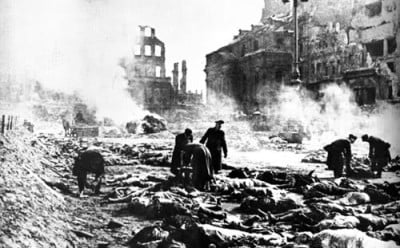This article was originally published in 2016.
On the night of February 13-14, 1945, the British Royal Air Force (RAF) bomber command carried out two devastating attacks on the German city of Dresden. At the time, Dresden’s pre-war population of 640,000 had been swelled by the presence of an estimated 100,000-200,000 refugees. Seven hundred and twenty-two aircraft dropped 1,478 tons of high explosives and 1,181 tons of incendiaries on the city. The resulting firestorm destroyed an area of 13 square miles, including the historic Altstadt Museum. Shortly after noon on February 14, a fleet of 316 U.S. bombers made a third attack, dropping a further 488 tons of high explosives and 294 tons of incendiaries. On February 15, two hundred and eleven U.S. bombers made a fourth attack, dropping 466 tons of high explosives.
The fire-bombing of Dresden was considered to be a gratuitous crime on the part of the British which caused up to 300,000 deaths.[1] Dresden was almost completely defenseless against the Anglo-American terror-attacks, which allowed the bombers to descend to lower levels and to maintain a steady height and heading, making their bombs even more effective.
Dresden had not previously been bombed during the war. The city was not considered a likely target because it was not a major contributor to the Nazi war economy and no key oil refineries or large armaments plants were located there. In the British Ministry of Economic Warfare’s 1943 “Bomber’s Baedeker,” Dresden was ranked 20th of 100 German towns in its importance to the German war effort. In fact, Dresden was best known worldwide as a site of architectural treasures and was sometimes referred to as the “German Florence.” Despite this, British Prime Minister Winston Churchill ordered the Dresden raids based on a plan submitted in August 1944 by Sir Charles Portal, Britain’s Chief of the Air Staff.[2]
Aftermath of the 1945 bombing of Dresden, Germany by Allied forces.
Codenamed “Operation Thunderclap,” the plan involved concentrating an entire attack on a single big town other than Berlin to try to inflict a single major blow on Germany using all available power. Portal opted for the “area bombing” of a city because cities afforded a big target. In January 1945, Churchill approved Portal’s plan, specifically in regards to large cities in eastern Germany, and demanded immediate action. The next day Churchill was told that Dresden, Berlin, and two other cities would be attacked as soon as conditions allowed.
Incendiaries, which are explicitly designed to start fires, were heavily used in the first three Dresden raids. The deadliness of the resulting firestorm was such that even people who took shelter from bombs underground in cellars or subways were either roasted to death by the heat or suffocated because the firestorm sucked the oxygen out of the air. This heavy use of incendiaries underlines once again that the Dresden attacks aimed to terrorize and kill people.[3] Confirming this further is the fact that Churchill specifically ordered that the terror-bombings be focused on Dresden’s working class areas. Or, even more blatantly, in the words of Arthur Harris, the commander of the RAF’s Bomber Command: “You destroy a factory and they rebuild it. In six weeks they are in operation again. I kill all their workmen and it takes twenty-one years to provide new ones.”[4]
The bombing of Dresden was an Anglo-American war crime never brought to trial.[5] A war crime, by definition, is any crime that transgresses the laws of war, and the bombing of civilians has long been banned by international law. The 1923 Hague Rules of Aerial Warfare declared: “Aerial bombardment for the purpose of terrorizing the citizen population, of destroying or damaging private property not of military character, or of injuring non-combatants is prohibited.” Even the Hitler-loving British Prime Minister Neville Chamberlain declared in 1938: “It is against international law to bomb civilians as such.” In the same year, the League of Nations Assembly unanimously accepted similar principles.[6]
Why was Dresden selected for the February 1945 bombings? Dresden was directly in the path of the advancing Soviet Army, who occupied the city shortly after the raids on their way to Berlin (Dresden was soon to be part of the post-war Soviet Zone). The idea was that the death and devastation caused by the bombing would be seen and reported back to Stalin, showing him the destructive capabilities of the U.S. and British bomber forces. With the end of the war only three months away, the aim of the Dresden raids was to try to intimidate Stalin and the Soviet Union so they would not stand up to the Anglo-American imperialists after the war.
About three weeks after Dresden, another similarly coded message was sent to Stalin and the Soviet Union via the U.S. imperialists’ firebombing of Tokyo, which incinerated between 80,000 and 200,000 people. In August 1945, the U.S. imperialists sent two new messages, targeting Hiroshima and Nagasaki to showcase the destructive force of their new atomic bomb. Just as Tokyo, Hiroshima, and Nagasaki had little or nothing to do with the war against the Japanese imperialists, Dresden had little or nothing to do with the war against the Nazis. But it had much, if not everything, to do with a new conflict in which the Nazis and the Japanese imperialists would be Anglo-American allies and the enemy would be the Soviet Union. The Cold War was born amid the ashes of the hundreds of thousands of non-combatants who were murdered in the deadly infernos of Dresden, Tokyo, Hiroshima and Nagasaki.
Notes
- In 2004 a commission of thirteen German historians mysteriously reduced this figure to the current official estimate of 25,000 deaths. This deliberate reduction to downplay the number of deaths parallels the imperialist campaign to reduce the number of deaths attributed to the Nazis, e.g., the number of official deaths at Auschwitz-Birkenau concentration camp was recently reduced from the immediate post-war figure of 4 million, agreed upon at the Nuremberg Trials, to 1.4 million.
- The most ludicrous theory of the origin of the Dresden raids is that Winston Churchill, the virulent anti-communist who initiated the 21-country invasion of the fledgling Soviet Union in 1918 and who made the Goebbels-inspired Iron Curtain speech in 1946 that officially opened the Cold War, carried out the Dresden raids because Stalin ordered him to! Of course, no documentation of this so-called order exists.
- Andrew Chandler, “The Church of England and the Obliteration Bombing of Germany in the Second World War.” English Historical Review, 108 (1993), pp. 920-46 (p. 931).
- Similarly, the U.S. imperialists used white phosphorus and napalm weapons to terrorize and kill civilians during the Korean and Viet Nam wars.
- See, for example, Donald Bloxham, “Dresden as a War Crime,” in Paul Addison & Jeremy Crang (eds.), Firestorm: The Bombing of Dresden, 1945. Chicago: Ivan Dee (2006).
- Adam Roberts & Richard Guelff, Documents on the Laws of War. Third Edition. Oxford University Press (2000), p. 22; Geoffrey Best, War and Law Since 1945. Oxford University Press (1997), p. 200.






/https://www.niagarafallsreview.ca/content/dam/thestar/news/canada/2021/09/25/huawei-executive-meng-wanzhou-receives-warm-welcome-upon-return-to-china/_1_meng_wanzhou_2.jpg)













No comments:
Post a Comment
Note: Only a member of this blog may post a comment.